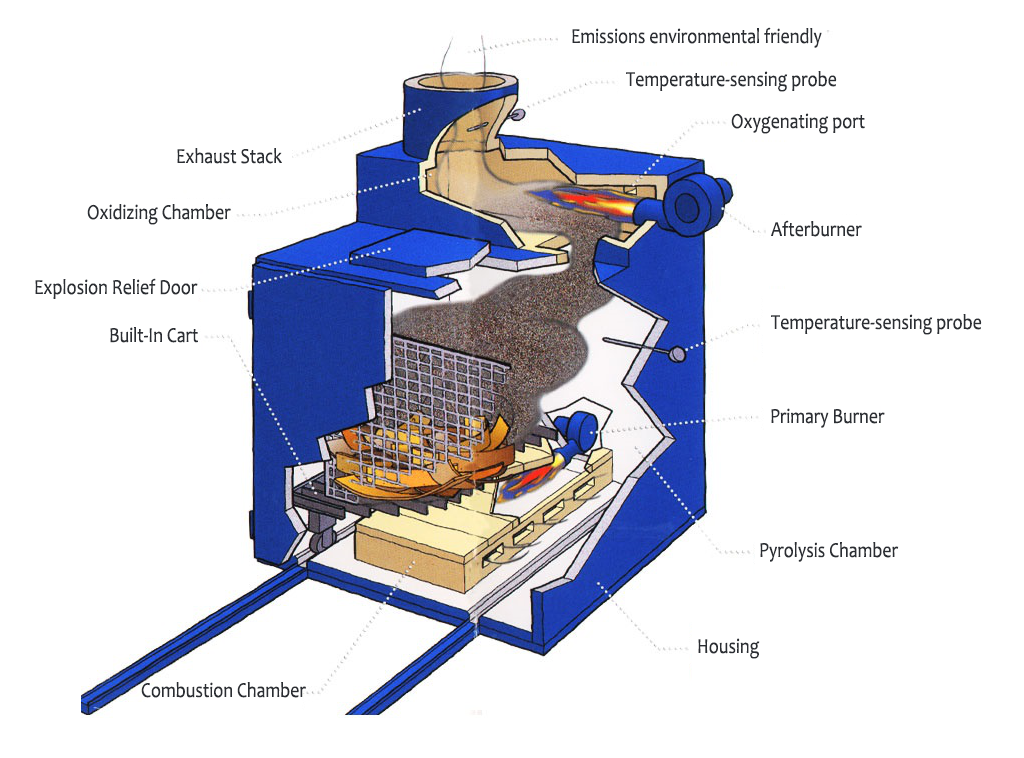Basic Introduction
Burn-off, burn-out, burn-in, thermal cleaning, pyrolysis... These ovens are described in different ways, but let's try to simplify the whole process.
Modern burn off ovens are the product of many years of evolutionary engineering. Top-down, bottom-up, integrated controllers, water spray cooling are some of the variations, but the basic concepts and science behind them are the same.
Modern burn off ovens consist of two chambers. They are actually two separate ovens that are bundled together, usually one on top of the other. Each chamber has its own burner, control mechanism and purpose.
There is a processing chamber that handles "stuff". There is another chamber where all the exhaust from the first chamber goes. The second chamber handles all fumes, volatile components and soot before venting to the outside world. This other chamber has different names such as secondary chamber, oxidizer, thermal oxidizer or afterburner.

What is it used for?
The "materials" processed by a burner refer to many things: motor stators, armatures, alternators, engine blocks, painted parts, coated parts, waste water, recycled metal scrap. Many different industries use furnaces to process a variety of materials.
Two of the most unusual applications I've seen for these ovens are recovering metals from oil filters by burning the oil and burning cows that died of mad cow disease.
It is for recycling rather than disposal
They are not incinerators. They don't handle waste. They recycle the material and use it again with little change in the material that is burned. This is a controlled process in which the substrate (usually metallic) is not damaged by high temperatures.
First chamber
The main chamber or processing chamber of the furnace operates at a temperature that thermally degrades and volatilizes organic materials on the substrate without damaging the substrate. The required temperature varies depending on the organic material, type of metal, and what is burned off. It also varies by end use. The nature of the burned-off organic matter also determines what temperature the chamber operates at.
Certain "materials" (such as motor parts) lose their magnetism if heated above 700 degrees Fahrenheit for extended periods of time. Steel loses many properties at high temperatures, and the normal maximum recommended temperature for steel components is about 900 degrees Fahrenheit.
Typically no degradation will occur until the part reaches 250 to 450 degrees Fahrenheit. But at these temperatures, the thermal degradation rate will be very low.
Parts should never be on fire
The purpose of this room is not to allow parts on fire. The aim is to degrade and volatilize organic materials in a controlled and oxygen-deficient environment. The key is to limit the amount of oxygen and thus control the process. There is not enough oxygen to burn quickly. The room is not completely airtight, but there is a limited amount of air coming in, so there is very little oxygen and the reaction is slow.
In the best case, no actual combustion occurs, but the organic material just evaporates. It evaporates at a temperature that does not affect the substrate. There should be no actual flame on the part.
The flame in a burner is usually contained within the firebox and only the heat reaches the parts. If the flames reach the parts, they can be severely damaged. Flames not contained in the firebox can damage carts or baskets containing parts.
Any holes in the oven or an open door or a poorly sealed door will allow more oxygen into the oven than it was designed for proper operation of the oven. Often the only source of air in the lower chamber is the burner's air intake, which is primarily the input air during the burner's "off" cycle. As it cycles on and off, we also open or close the oxygen valve.
The key to this chamber is to control the amount of fuel and oxygen coming in. Fuel doesn't just mean gas. It also means that the organic material is burned off. Slow-burning organic matter adds fuel value.
Second Chamber
The oxygen-deficient air from the lower chamber contains volatile organic components. These do not burn completely, but consist of gas, smoke and soot. These gases and soot go into the next chamber, the auxiliary combustion chamber or afterburner of the oven.
This chamber operates at a higher temperature. It has an opening somewhere that allows outside air to enter the chamber at a controlled rate. There is enough extra air in to complete the work started in the first chamber. Higher heat and more oxygen cause the gas and soot to burn completely. Little or no organic material remains. In theory, in a properly functioning oven, the only things coming out of the chimney are carbon dioxide and water vapor.
Contact: Alice
Phone:
E-mail: alicexu@ecoco-oven.com
Whatsapp:+86 18151380595
Add: Room 122-2, No.3 Business Building Shengyuan Community, Tinghu District, 224001, Yancheng City, Jiangsu, China
We chat
